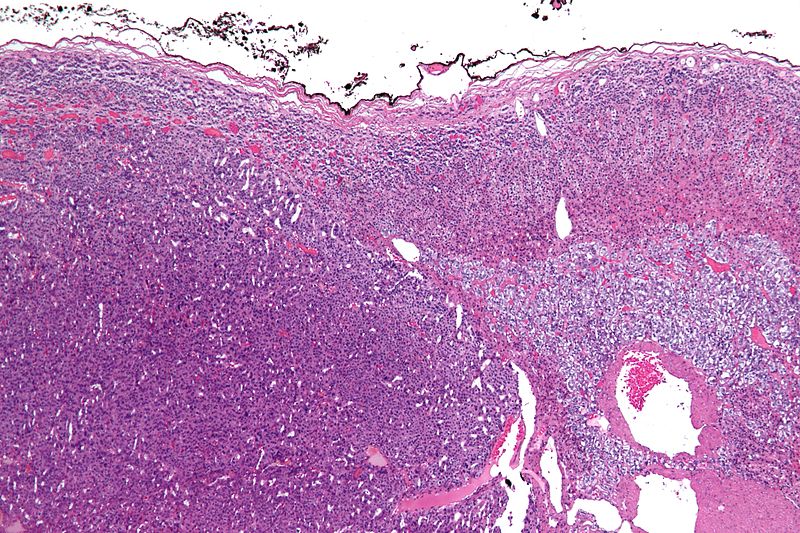Adrenal carcinoma pathophysiology: Difference between revisions
No edit summary |
|||
| Line 5: | Line 5: | ||
==Pathophysiology== | ==Pathophysiology== | ||
Adrenal tumors are often not biopsied prior to surgery, so diagnosis is confirmed on examination of the surgical specimen by a [[anatomical pathology|pathologist]]. Grossly, adrenocortical carcinomas are often large, with a tan-yellow cut surface, and areas of [[hemorrhage]] and [[necrosis]]. On [[histopathology|microscopic examination]], the tumor usually displays sheets of atypical cells with some resemblance to the cells of the normal [[adrenal cortex]]. The presence of [[invasion]] and [[mitosis|mitotic activity]] help differentiate small cancers from [[adrenocortical adenoma]]s.<ref name="Weidner's">{{cite book |author=Richard Cote, Saul Suster, Lawrence Weiss, Noel Weidner (Editor) |title=Modern Surgical Pathology (2 Volume Set) |publisher=W B Saunders |location=London |year= |pages= |isbn=0-7216-7253-1 |oclc= |doi=}}</ref> | Adrenal tumors are often not biopsied prior to surgery, so diagnosis is confirmed on examination of the surgical specimen by a [[anatomical pathology|pathologist]]. Grossly, adrenocortical carcinomas are often large, with a tan-yellow cut surface, and areas of [[hemorrhage]] and [[necrosis]]. On [[histopathology|microscopic examination]], the tumor usually displays sheets of atypical cells with some resemblance to the cells of the normal [[adrenal cortex]]. The presence of [[invasion]] and [[mitosis|mitotic activity]] help differentiate small cancers from [[adrenocortical adenoma]]s.<ref name="Weidner's">{{cite book |author=Richard Cote, Saul Suster, Lawrence Weiss, Noel Weidner (Editor) |title=Modern Surgical Pathology (2 Volume Set) |publisher=W B Saunders |location=London |year= |pages= |isbn=0-7216-7253-1 |oclc= |doi=}}</ref> | ||
===Microscopic Pathology=== | |||
Shown below is a micrograph of an adrenocortical carcinoma (left of image - dark blue) and the adrenal cortex it arose from (right-top of image - pink/light blue). Benign adrenal medulla is present (right-middle of image - gray/blue). H&E stain. | |||
[[Image: 800px-Adrenal_cortical_carcinoma_-_low_mag.jpg|400px]] | |||
===Genetics=== | ===Genetics=== | ||
| Line 11: | Line 15: | ||
==References== | ==References== | ||
{{reflist|2}} | {{reflist|2}} | ||
[[Category:Disease]] | [[Category:Disease]] | ||
[[Category:Endocrinology]] | [[Category:Endocrinology]] | ||
[[Category:Oncology]] | [[Category:Oncology]] | ||
[[Category:Needs Overview]] | |||
{{WH}} | |||
{{WS}} | |||
Revision as of 16:55, 6 March 2013
|
Adrenal Carcinoma Microchapters |
|
Diagnosis |
|---|
|
Treatment |
|
Case Studies |
|
Adrenal carcinoma pathophysiology On the Web |
|
American Roentgen Ray Society Images of Adrenal carcinoma pathophysiology |
|
Risk calculators and risk factors for Adrenal carcinoma pathophysiology |
Editor-In-Chief: C. Michael Gibson, M.S., M.D. [1]
Overview
Pathophysiology
Adrenal tumors are often not biopsied prior to surgery, so diagnosis is confirmed on examination of the surgical specimen by a pathologist. Grossly, adrenocortical carcinomas are often large, with a tan-yellow cut surface, and areas of hemorrhage and necrosis. On microscopic examination, the tumor usually displays sheets of atypical cells with some resemblance to the cells of the normal adrenal cortex. The presence of invasion and mitotic activity help differentiate small cancers from adrenocortical adenomas.[1]
Microscopic Pathology
Shown below is a micrograph of an adrenocortical carcinoma (left of image - dark blue) and the adrenal cortex it arose from (right-top of image - pink/light blue). Benign adrenal medulla is present (right-middle of image - gray/blue). H&E stain.
Genetics
The main etiologic factor of adrenocortical cancer is unknown. Families with Li-Fraumeni syndrome have increased risk. The p53, retinoblastoma protein (RB) tumor suppressor genes located on chromosomes 17p, 13q respectively, may be changed. The genes h19, insulin-like growth factor II (IGF-II), p57kip2 are important for fetal growth and development. They are located on chromosome 11p. Expression of the h19 gene is markedly reduced in both nonfunctioning and functioning adrenal cortical carcinomas, especially in tumors producing cortisol and aldosterone. There is also a loss of activity of the p57kip2 gene product in virilizing adenomas and adrenal cortical carcinomas. In contrast, IGF-II gene expression has been shown to be high in adrenal cortical carcinomas. Finally, c-myc gene expression is relatively high in neoplasms, and it is often linked to poor prognosis.[2]
References
- ↑ Richard Cote, Saul Suster, Lawrence Weiss, Noel Weidner (Editor). Modern Surgical Pathology (2 Volume Set). London: W B Saunders. ISBN 0-7216-7253-1.
- ↑ Kufe D (2000). Benedict RC, Holland JF, ed. Cancer medicine (5th ed.). Hamilton, Ont: B.C. Decker. ISBN 1-55009-113-1. OCLC 156944448.
